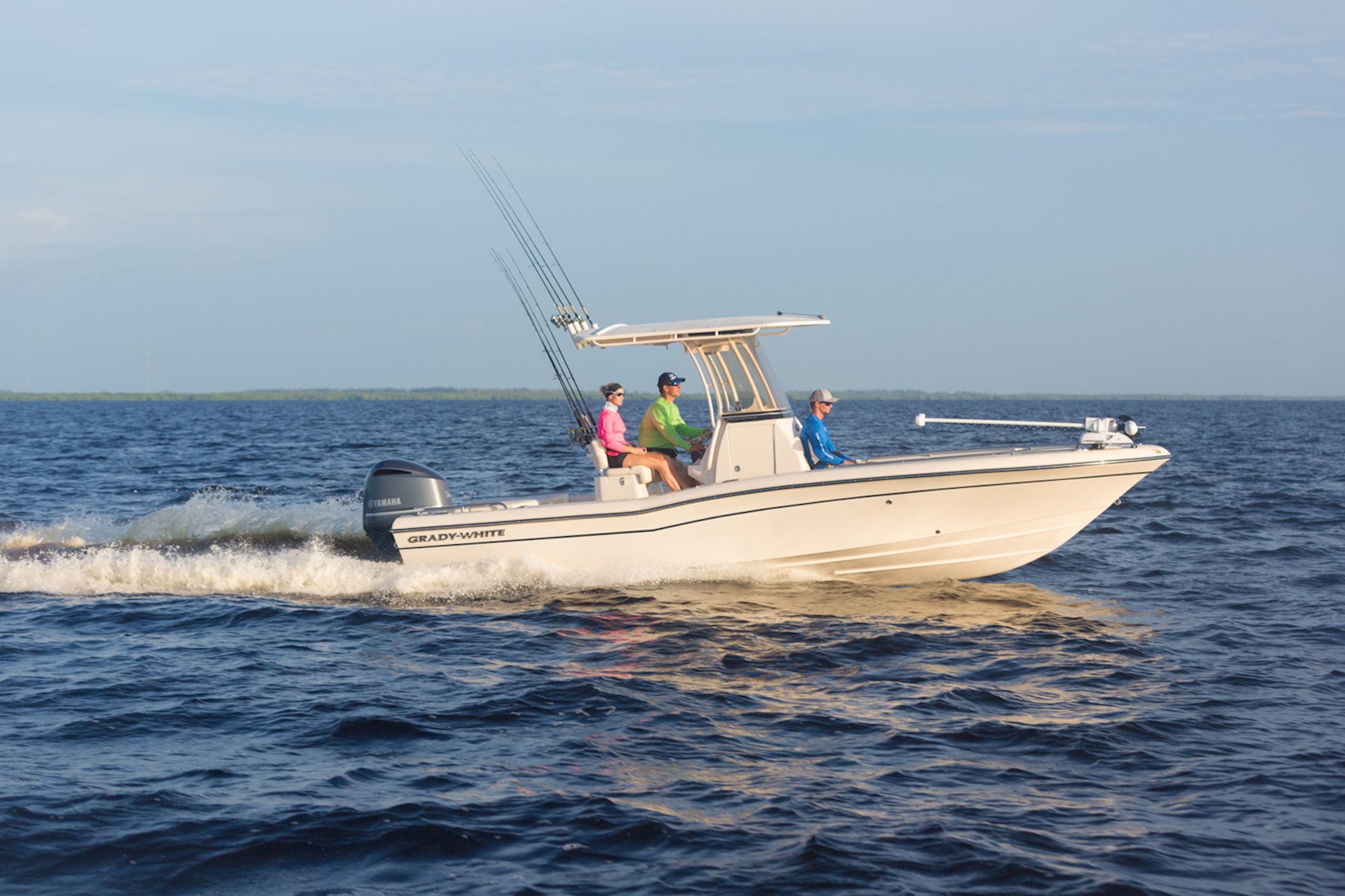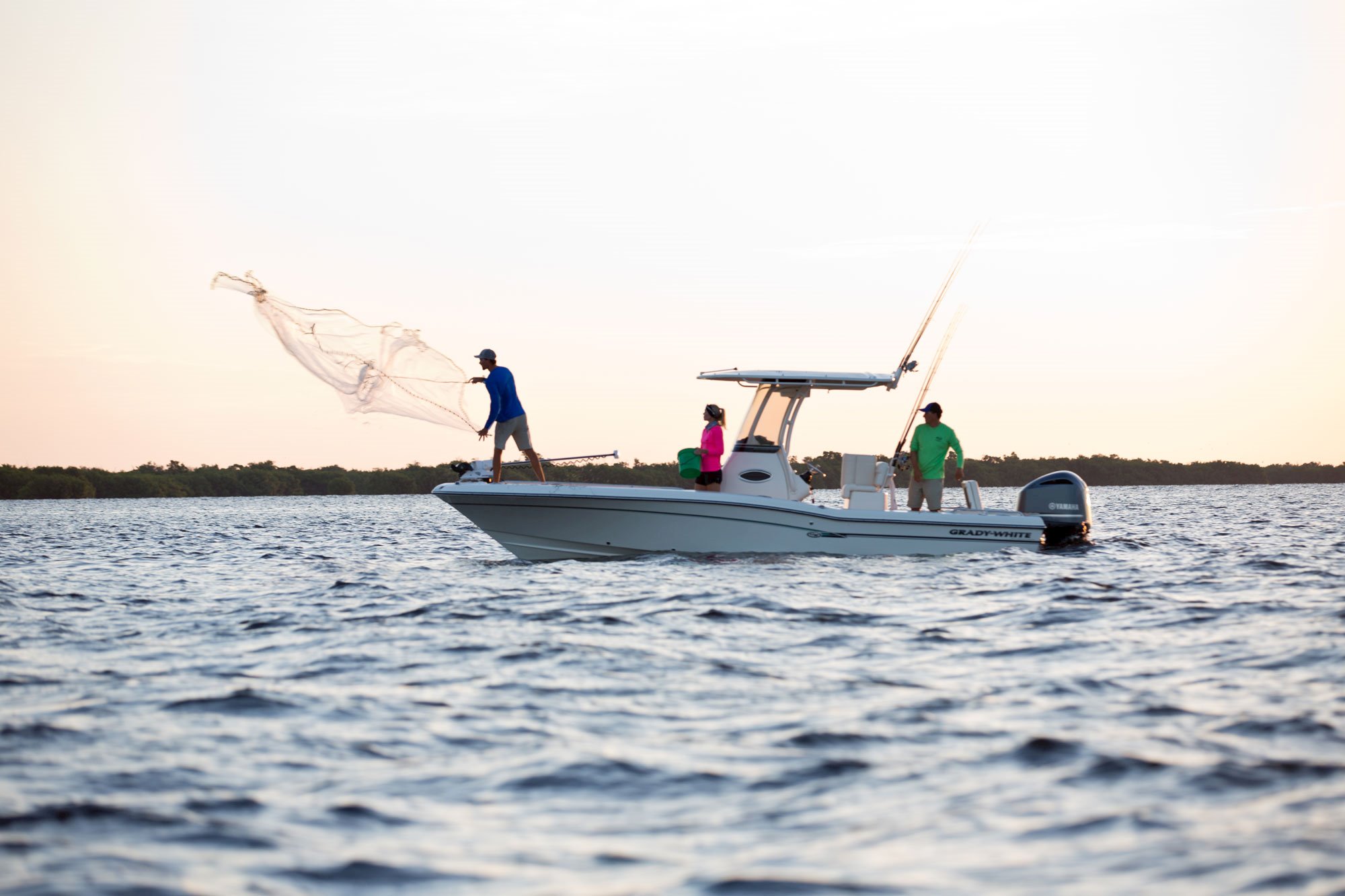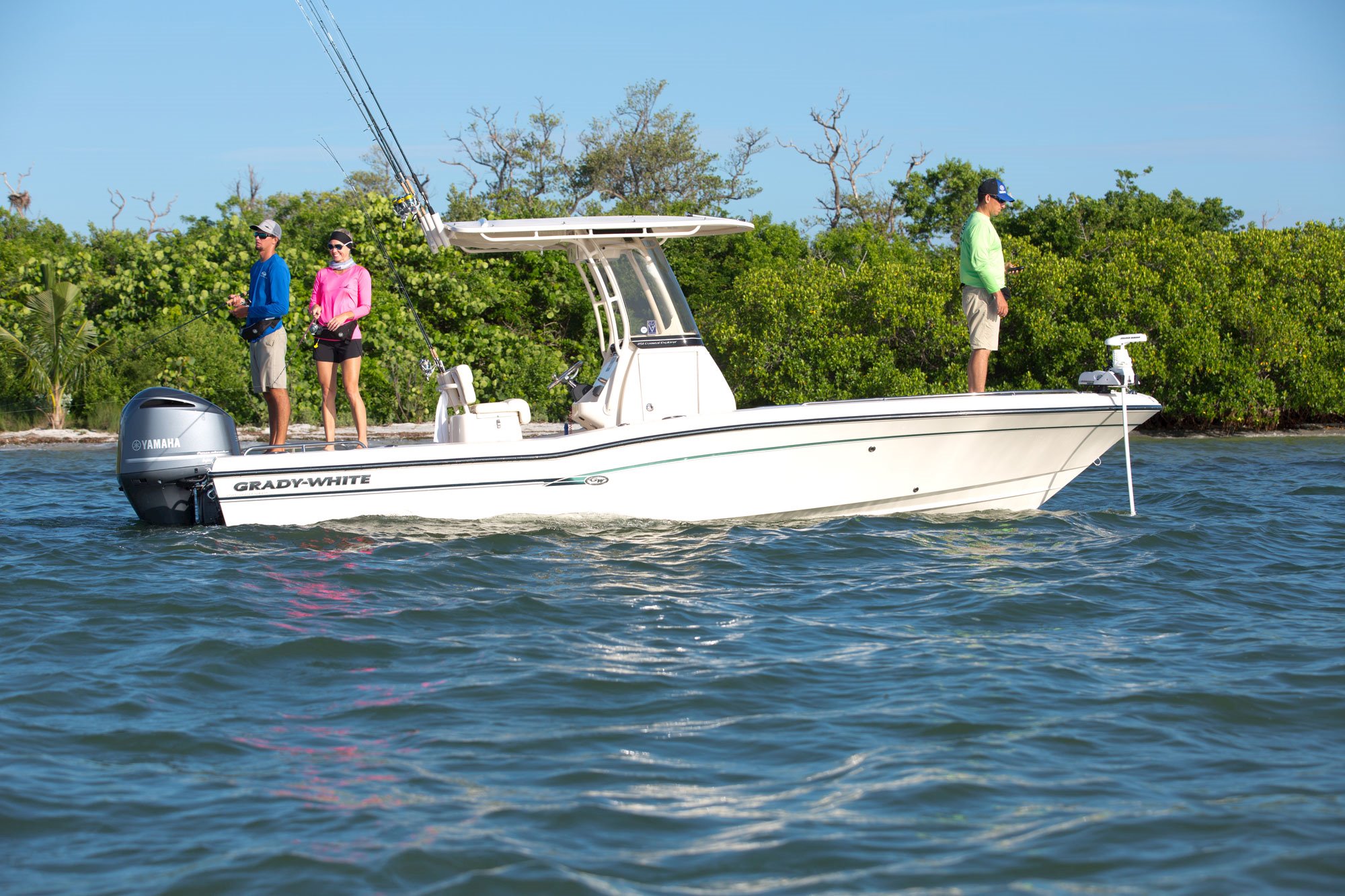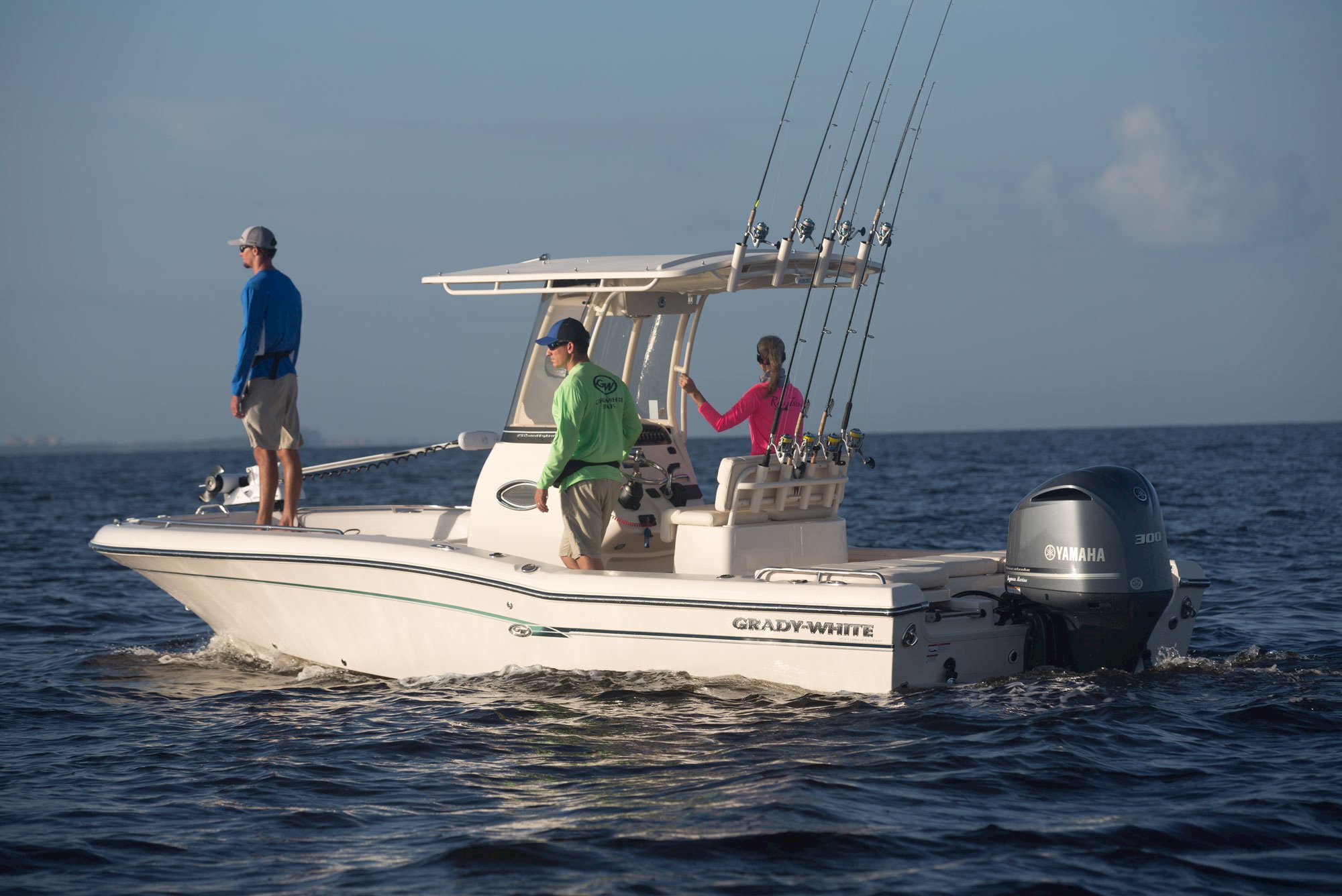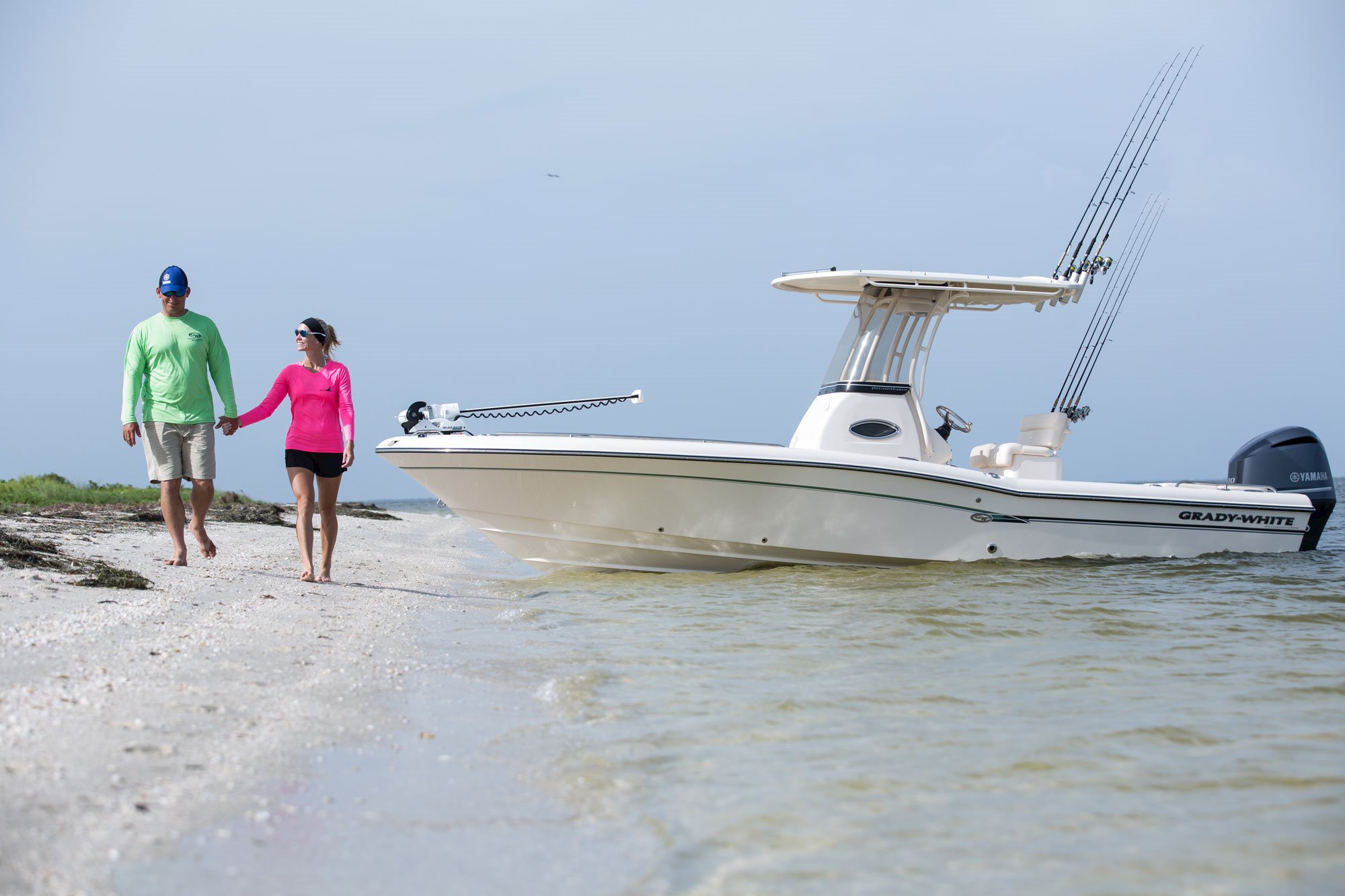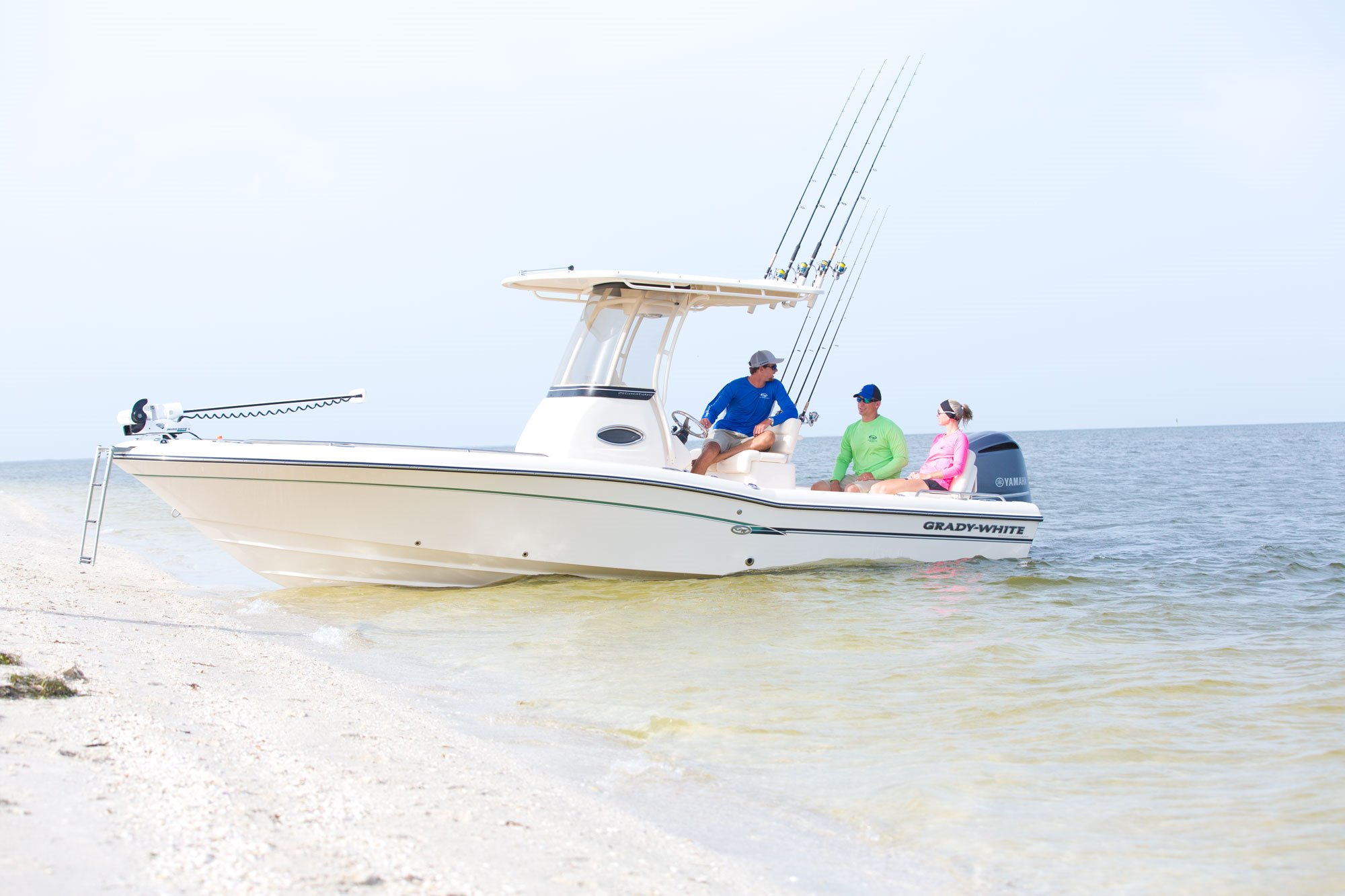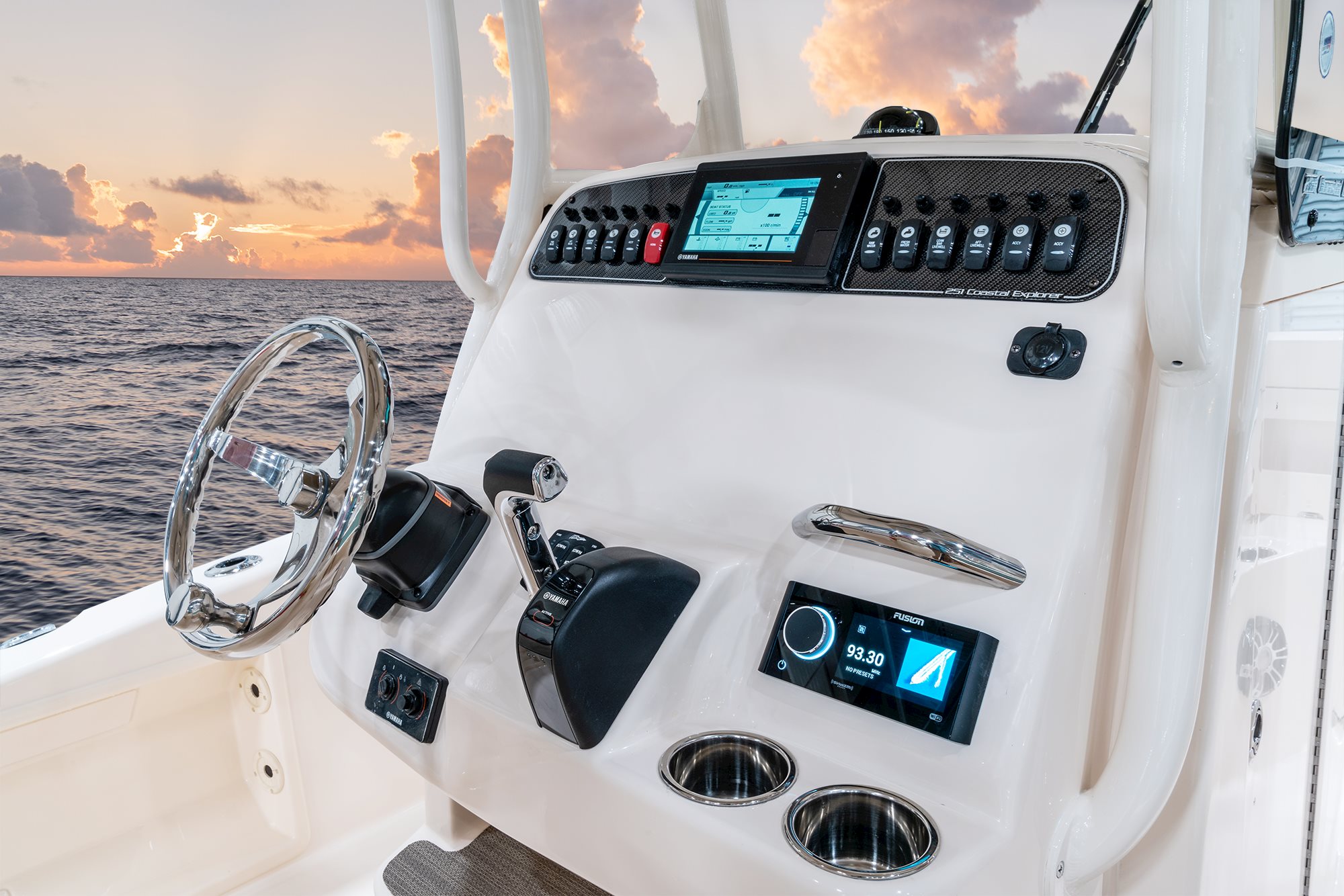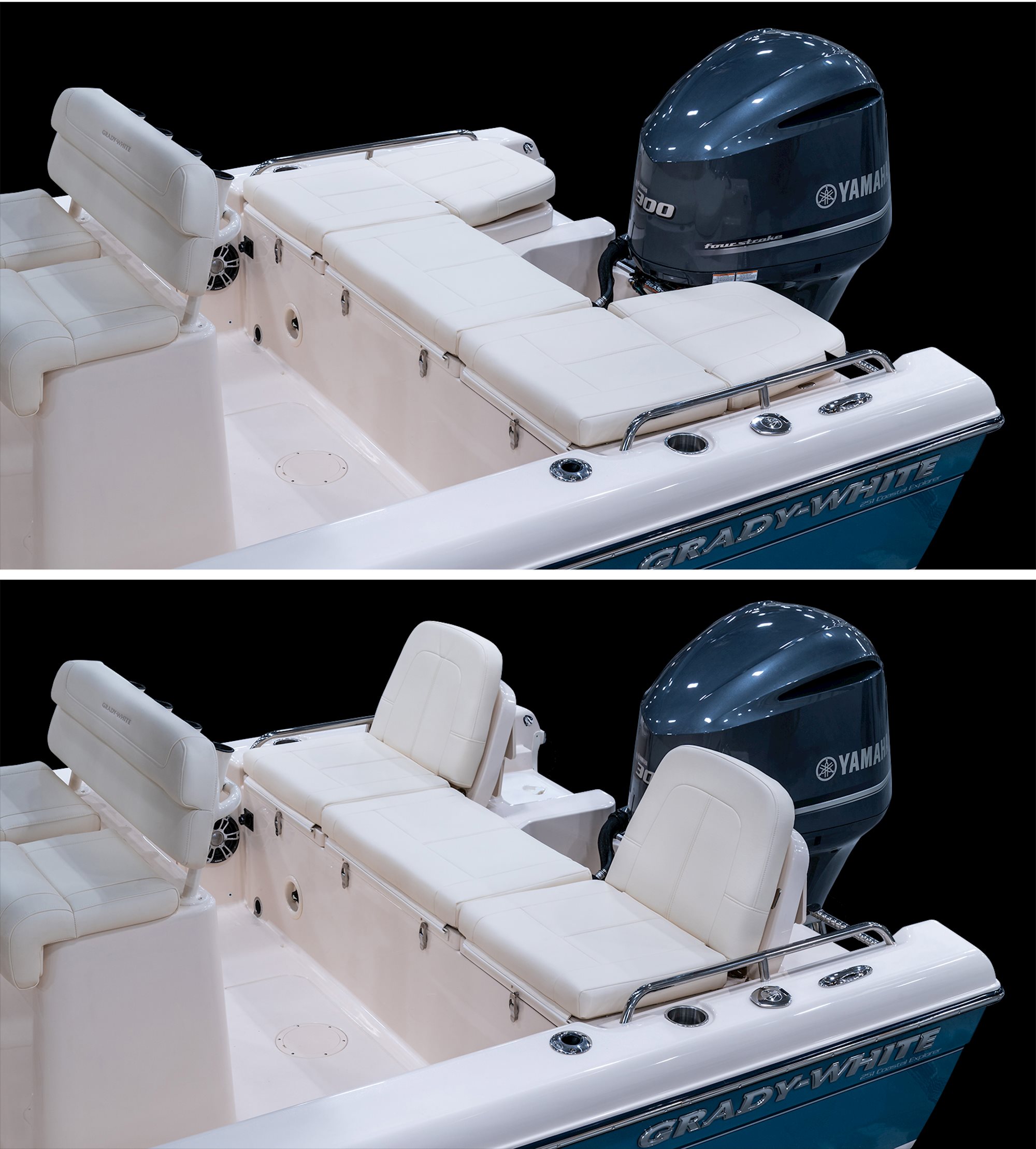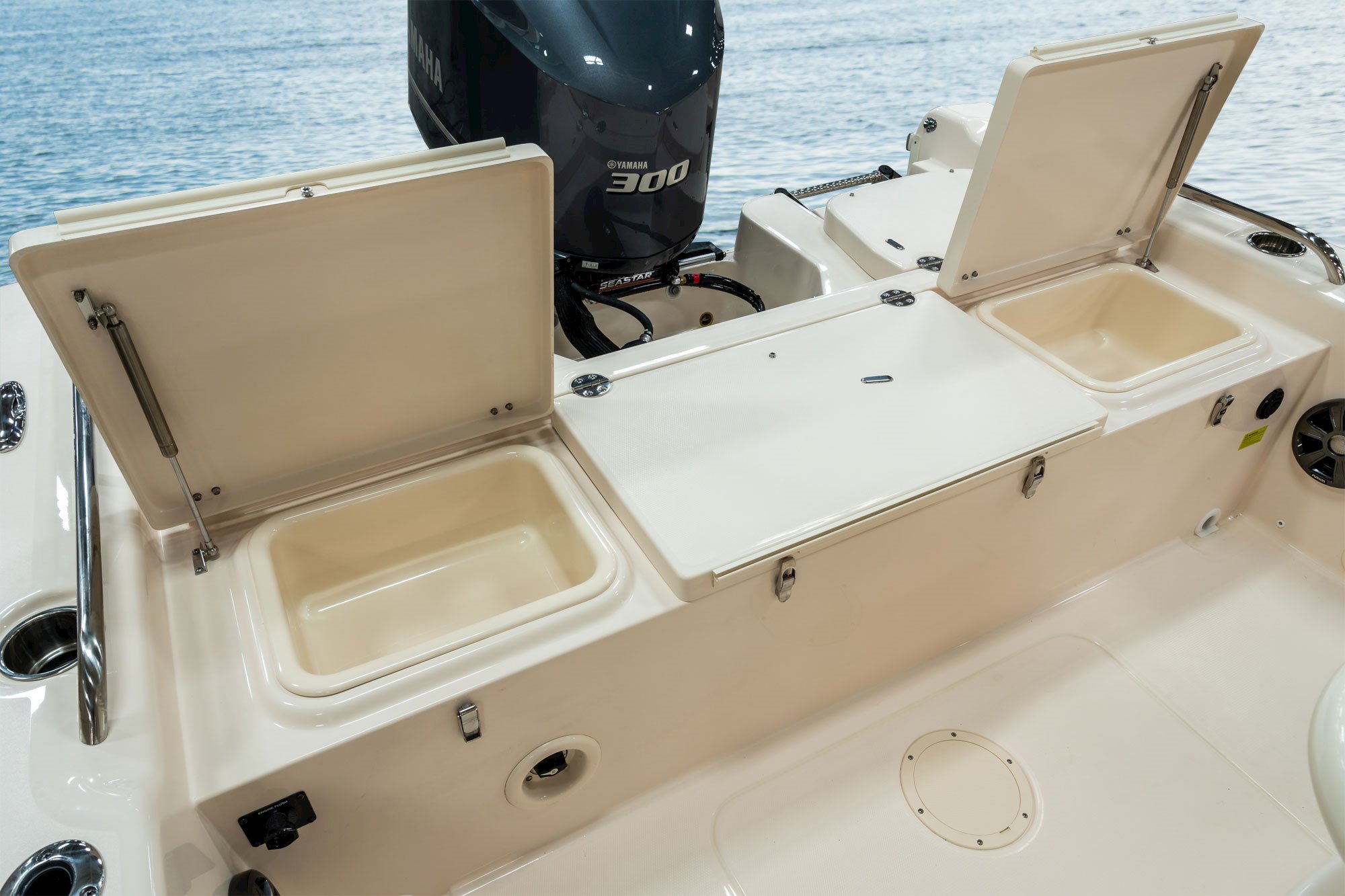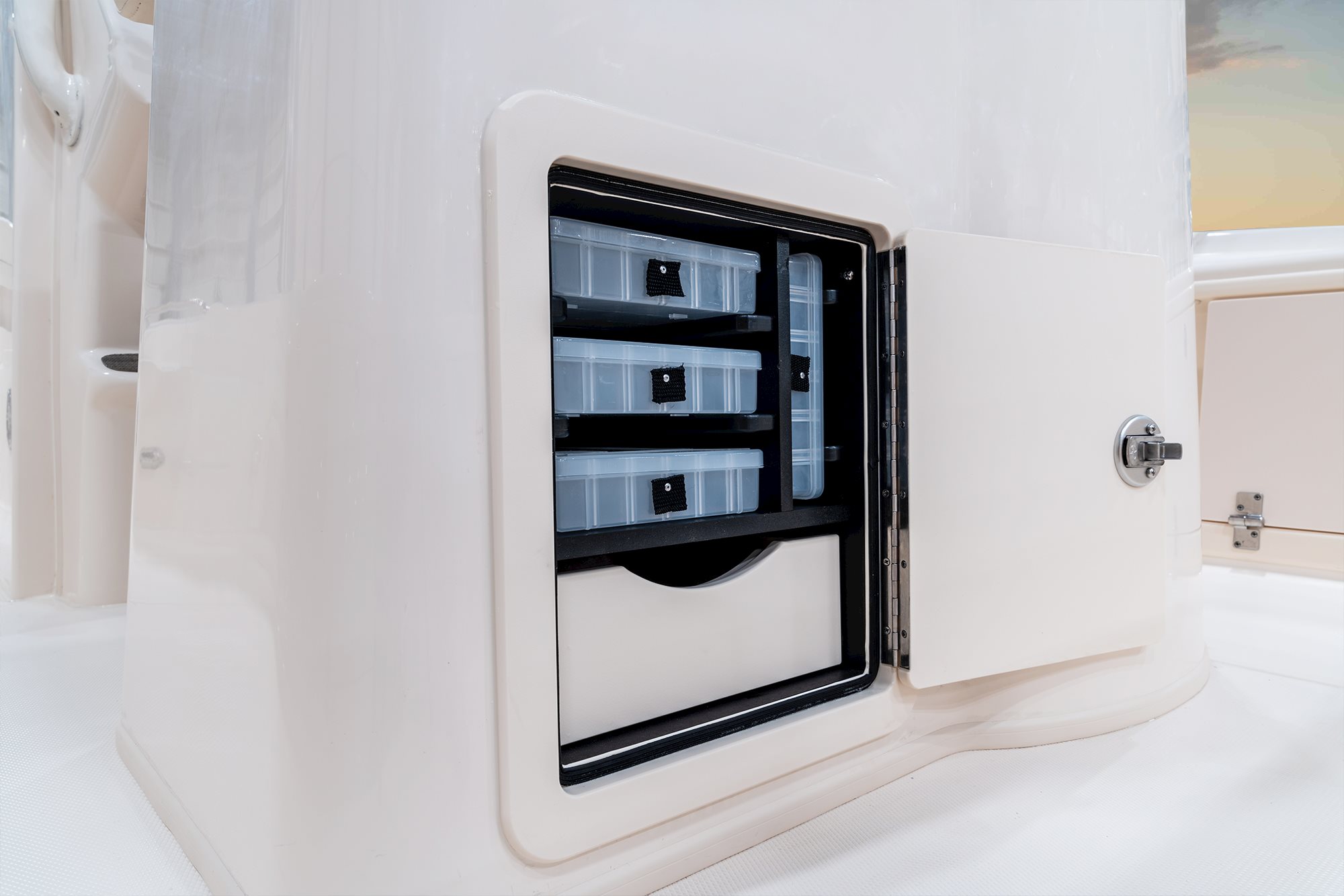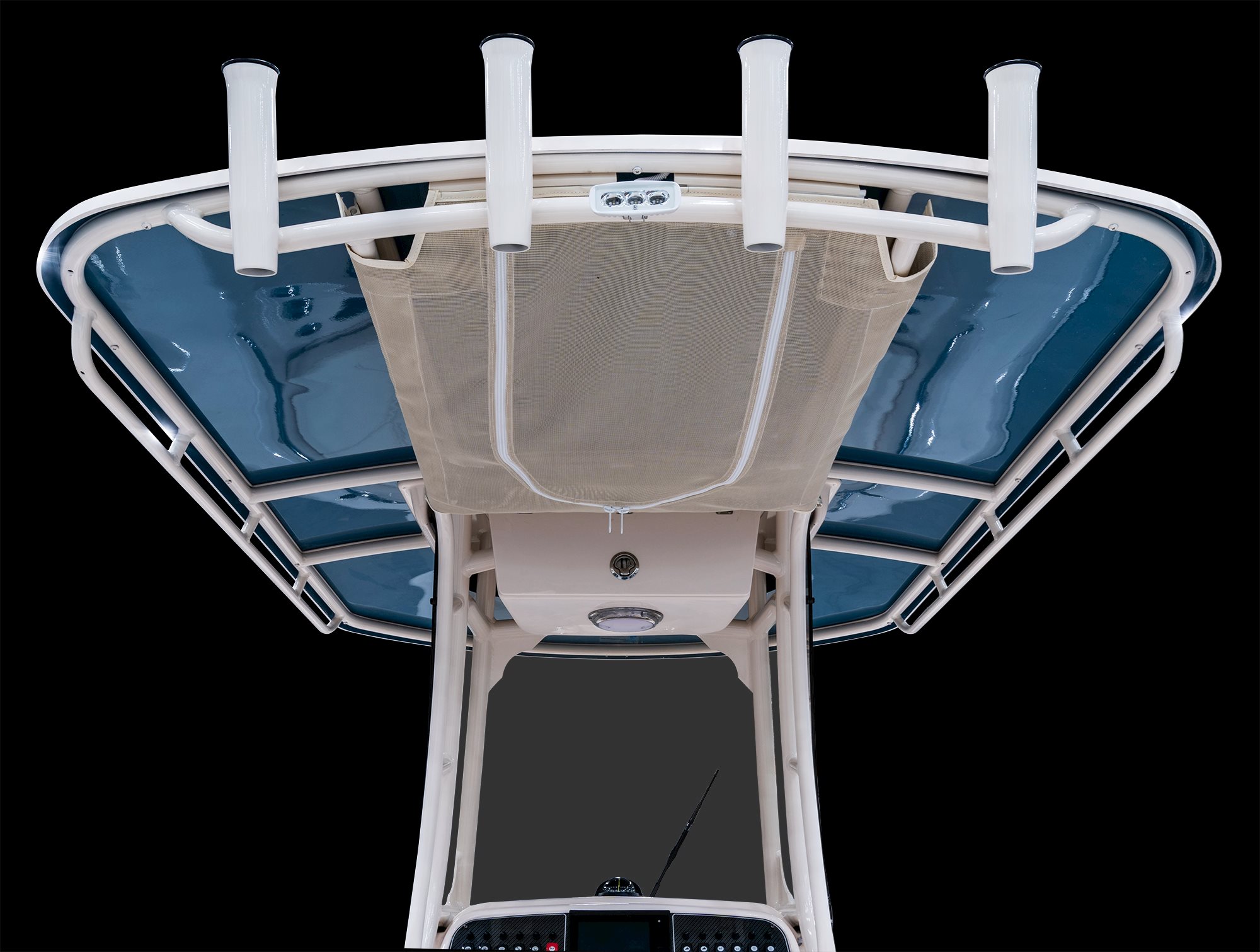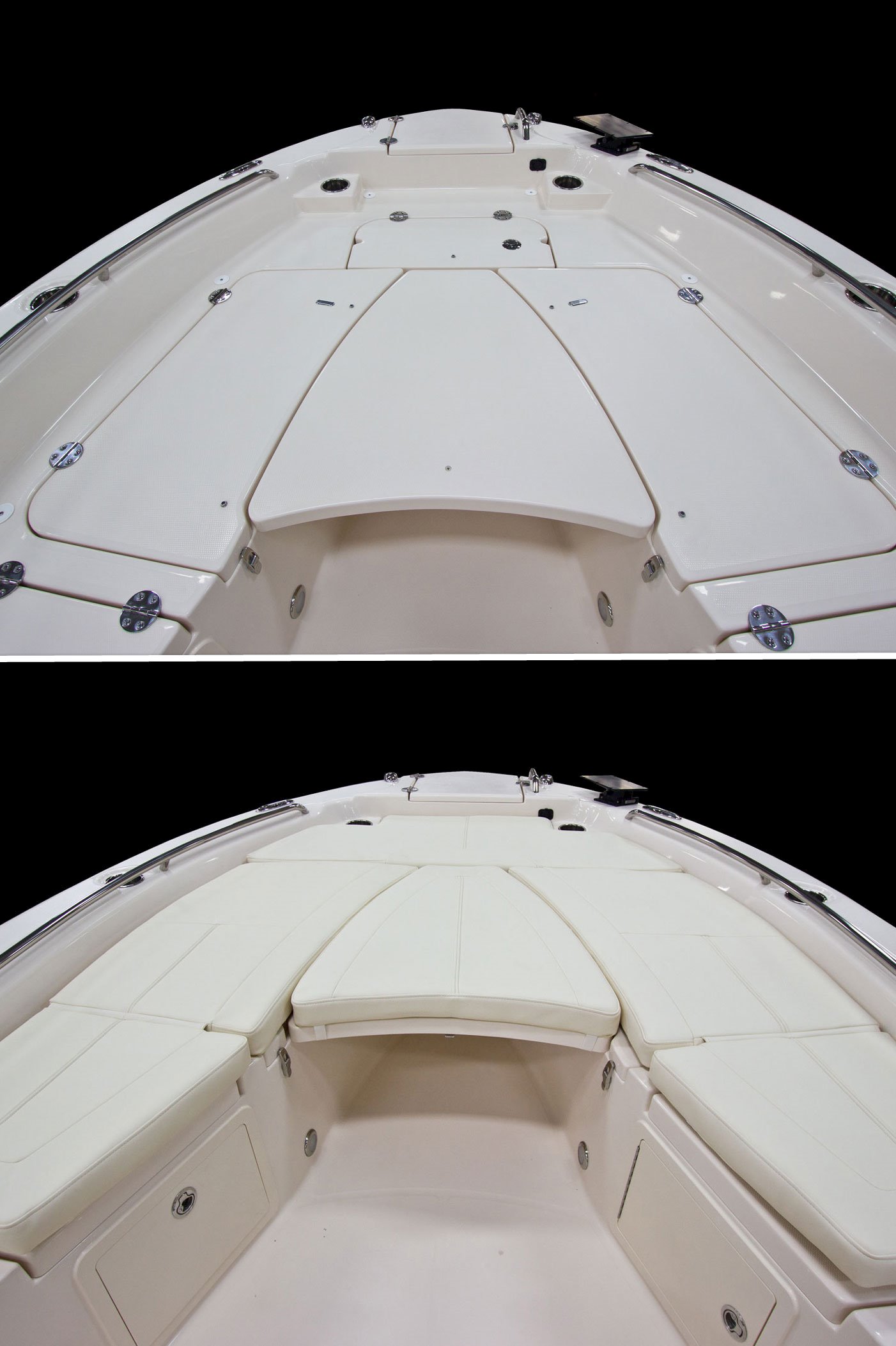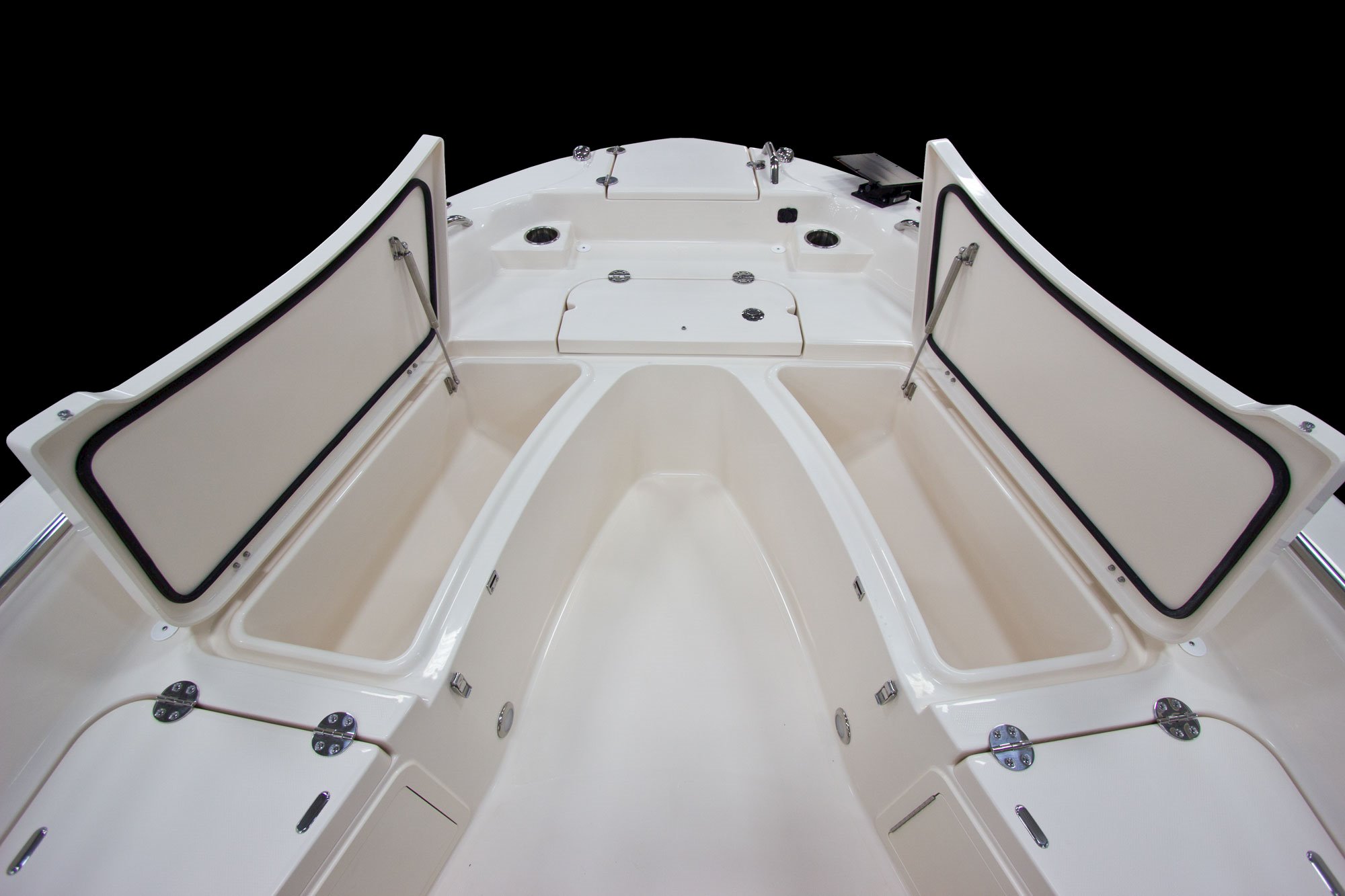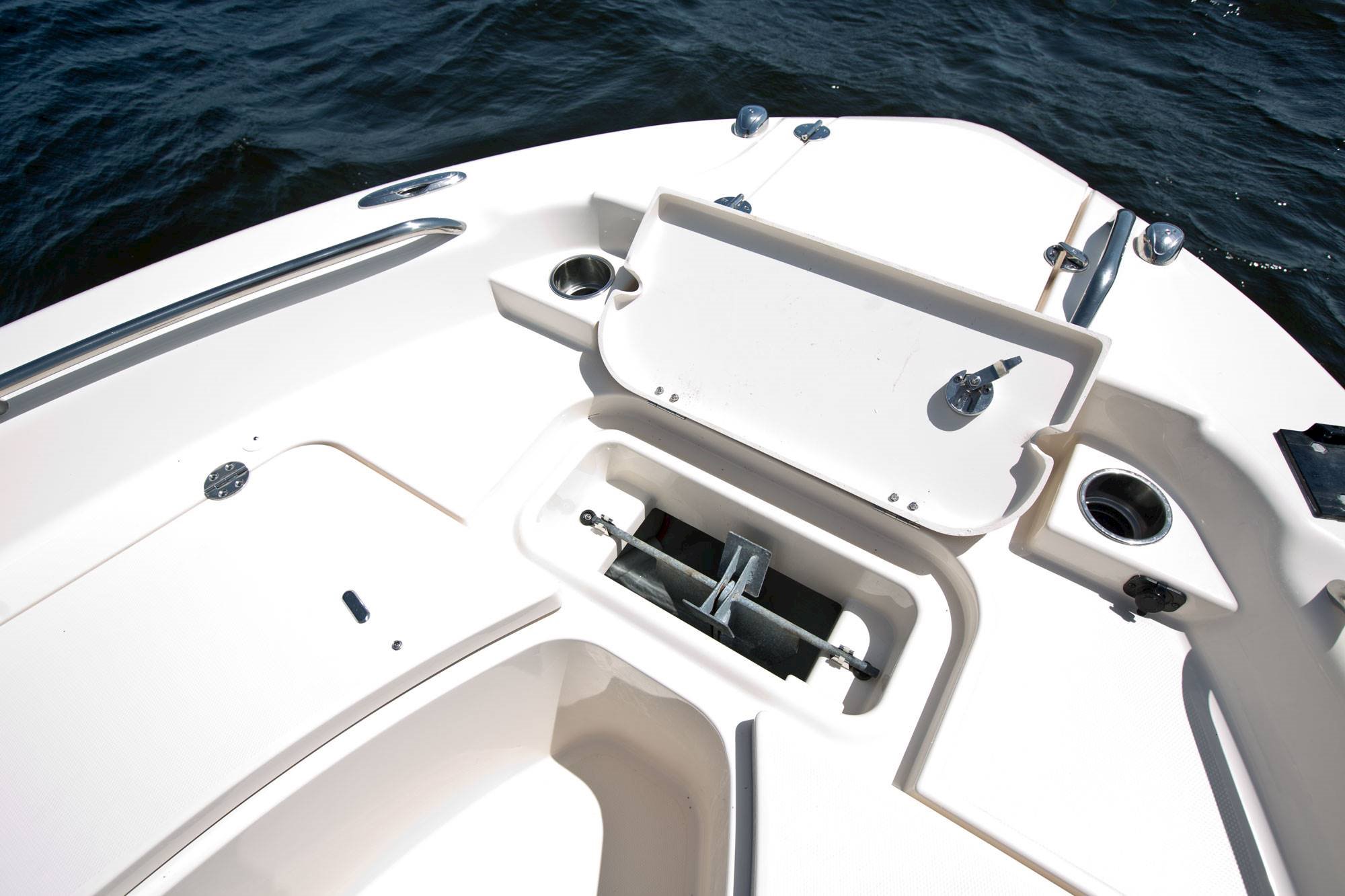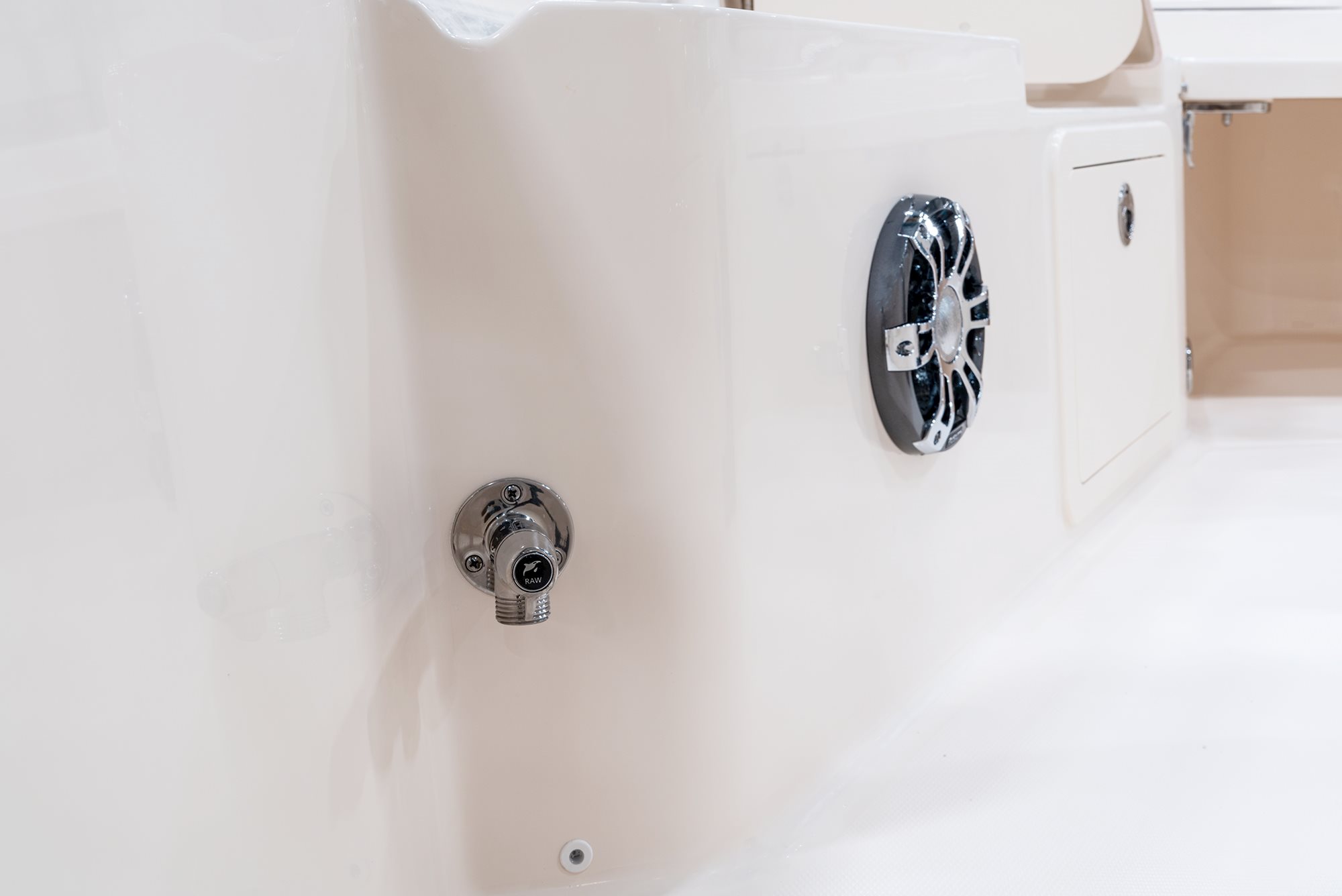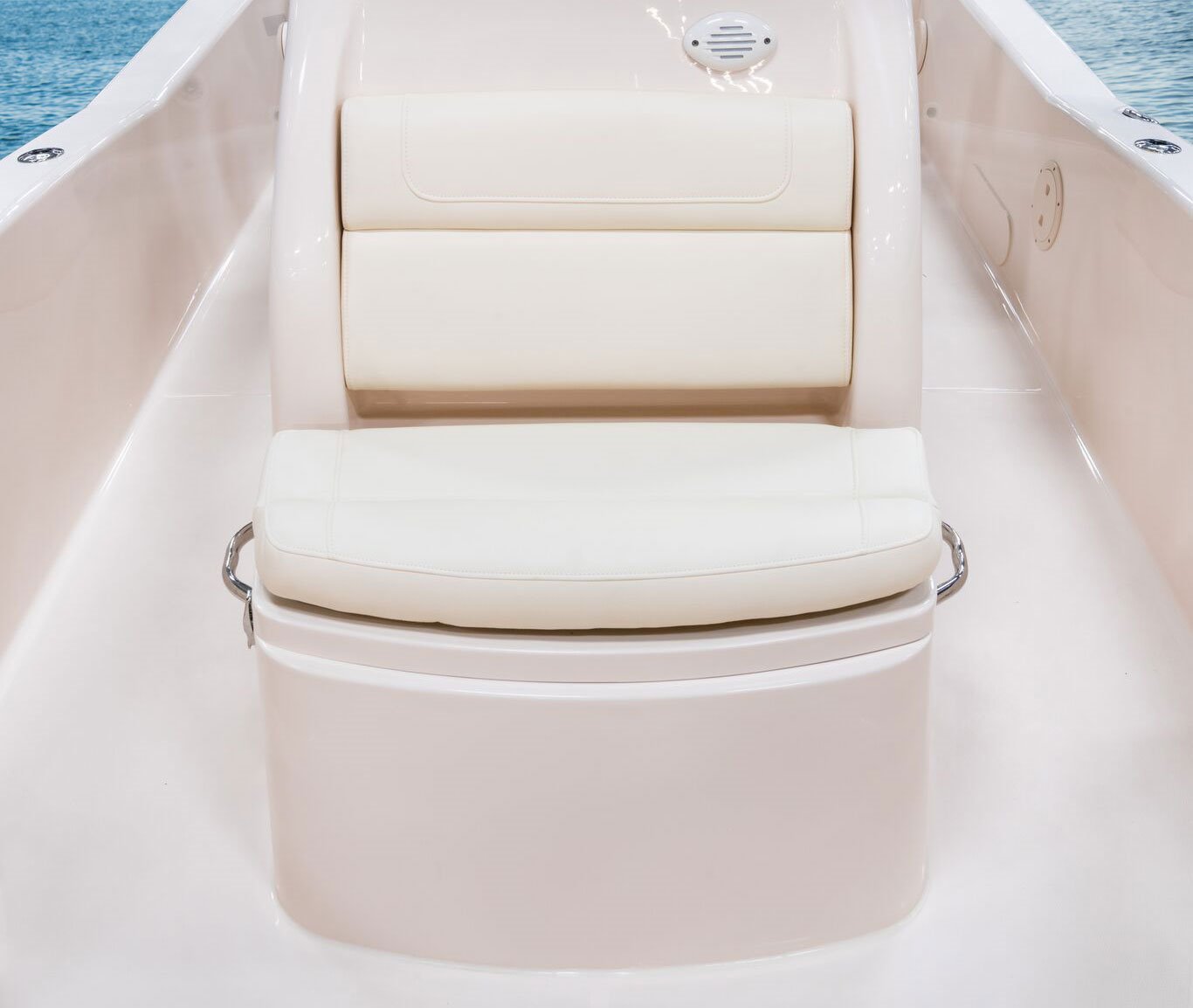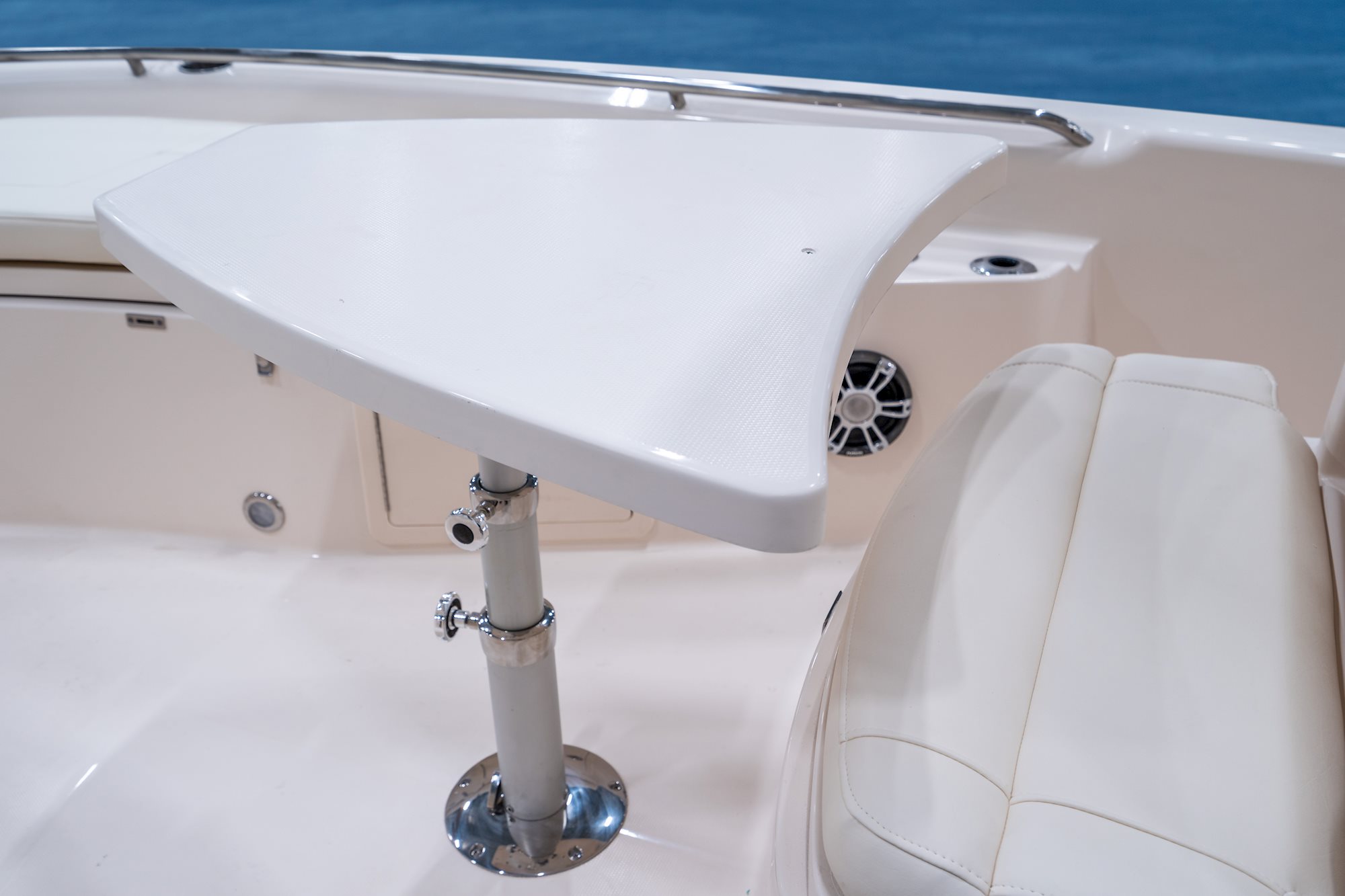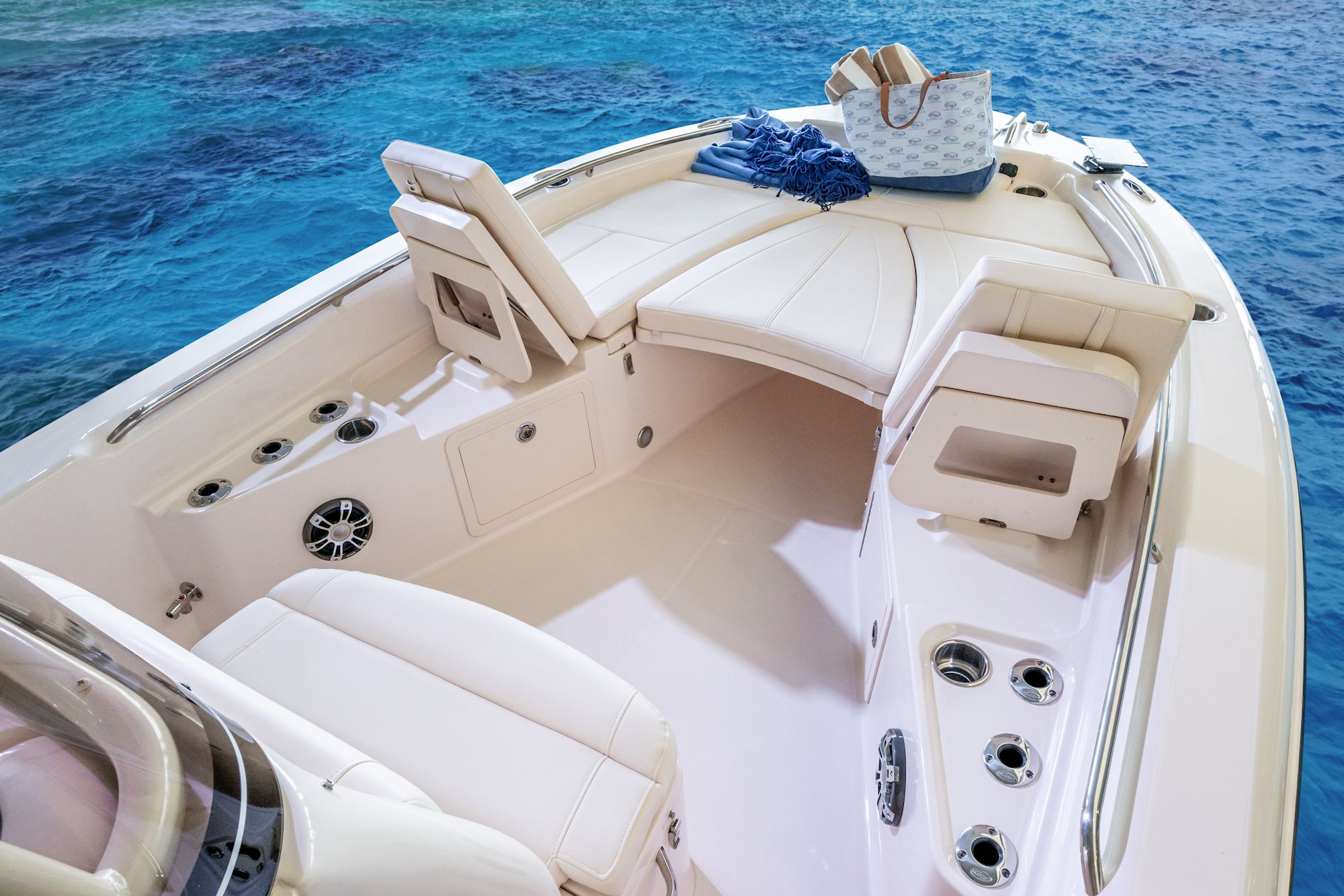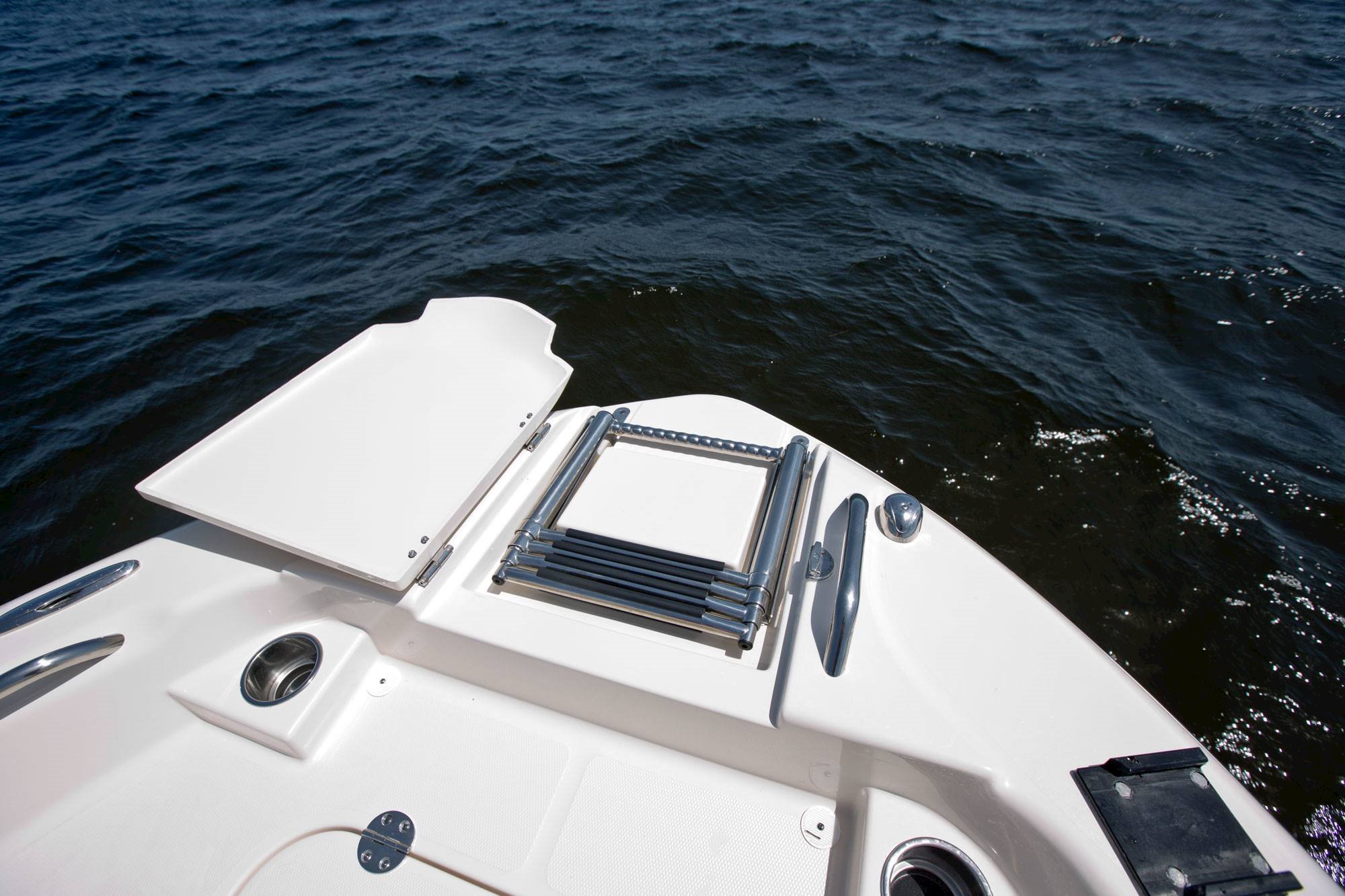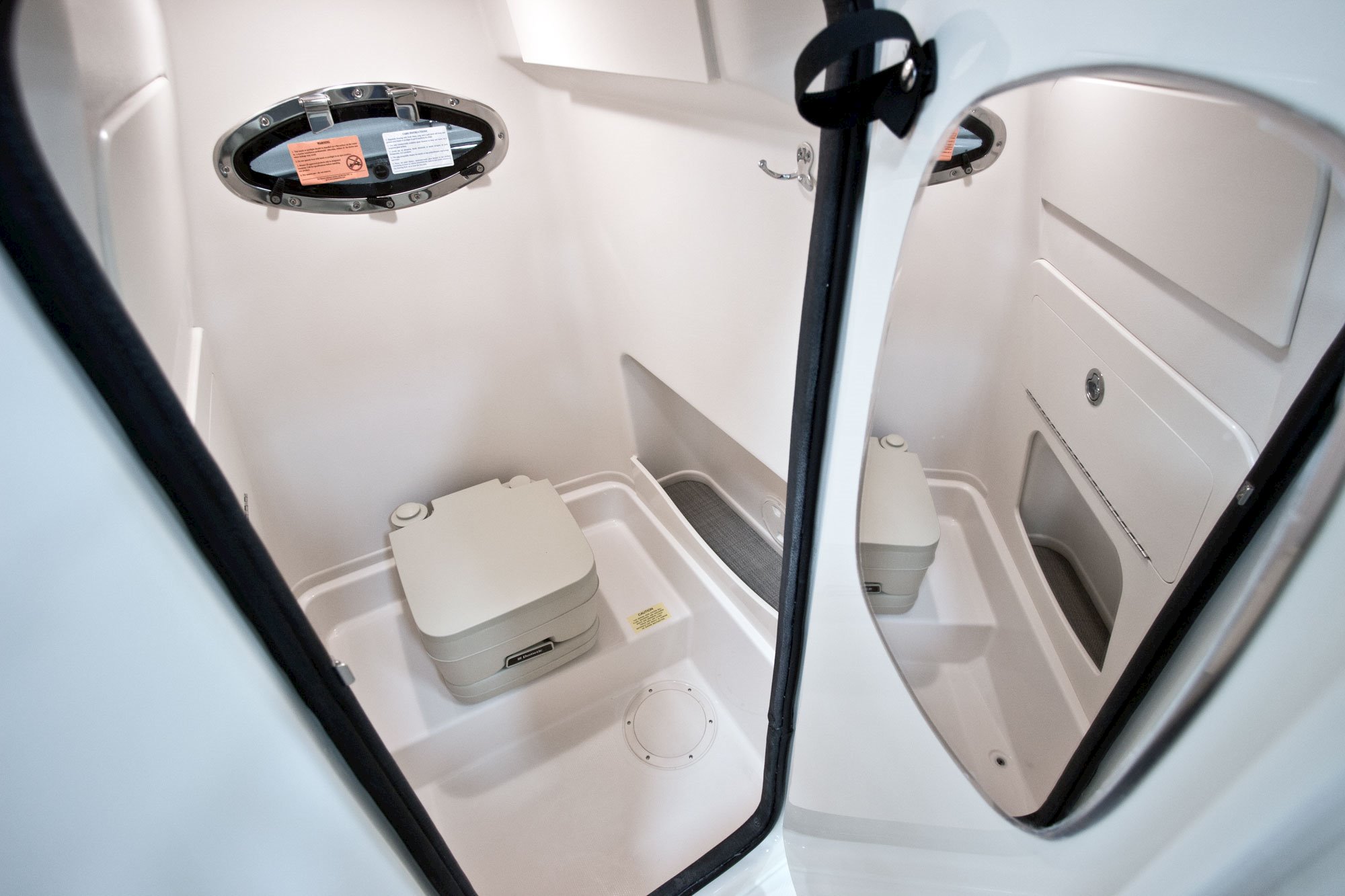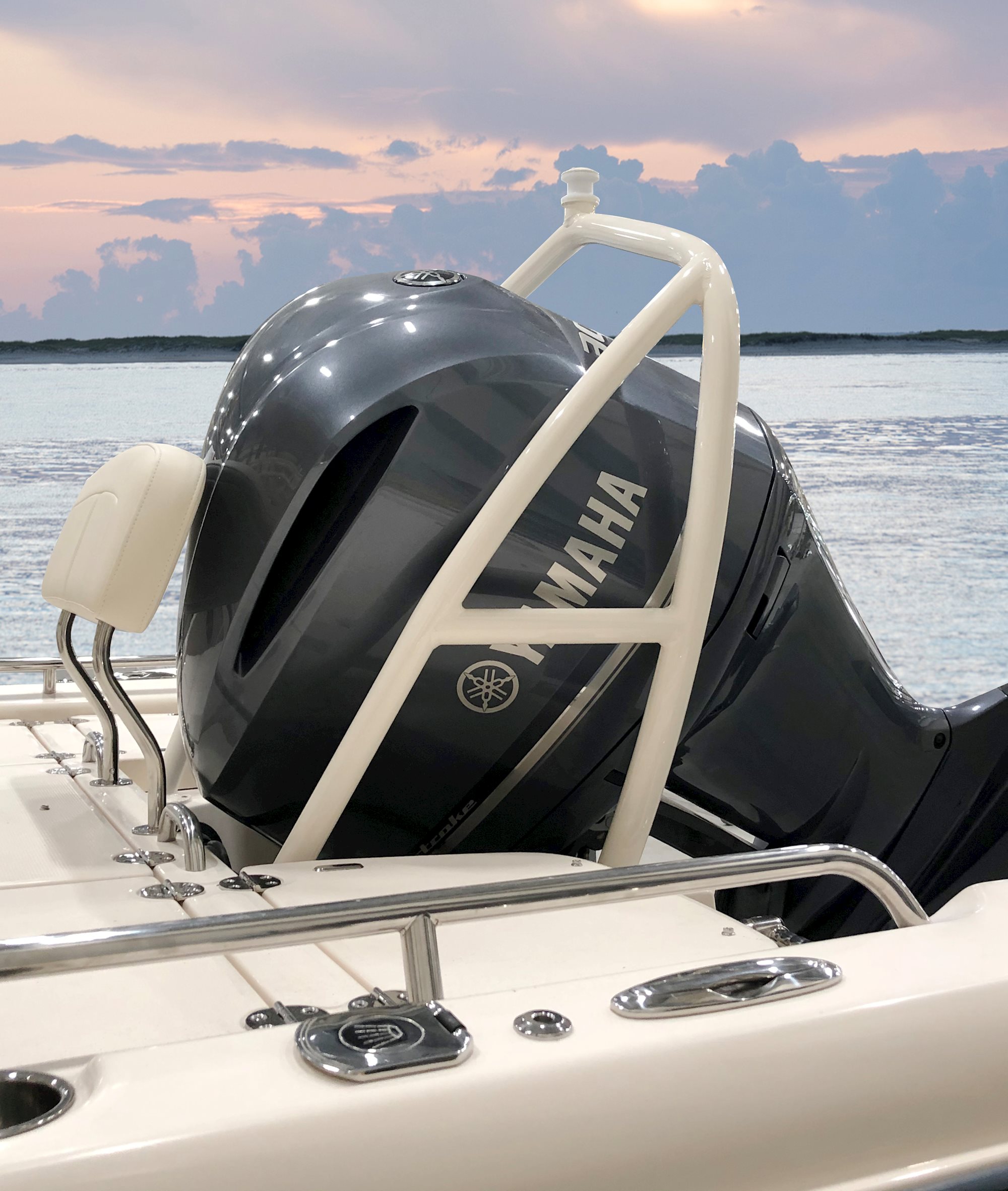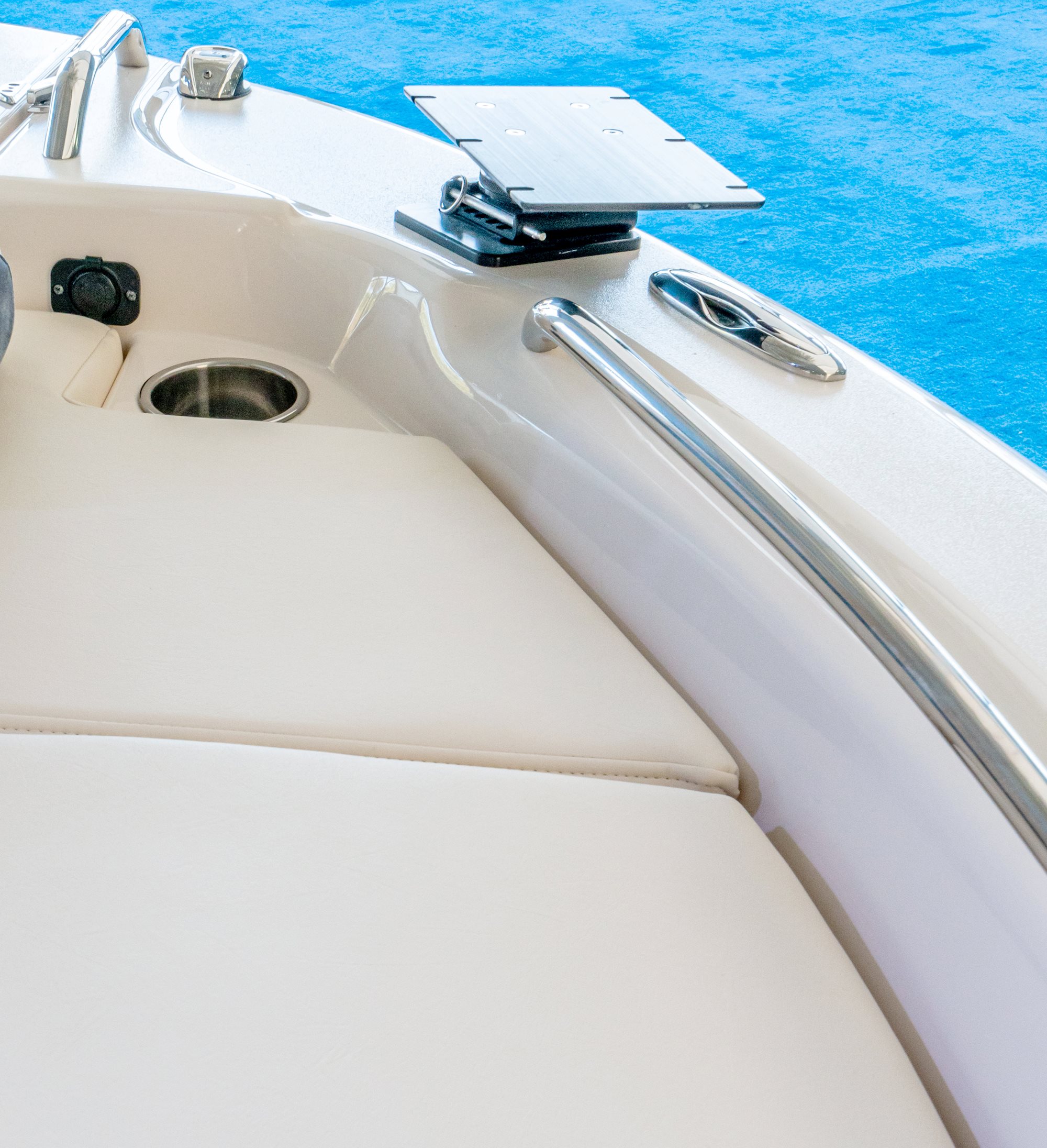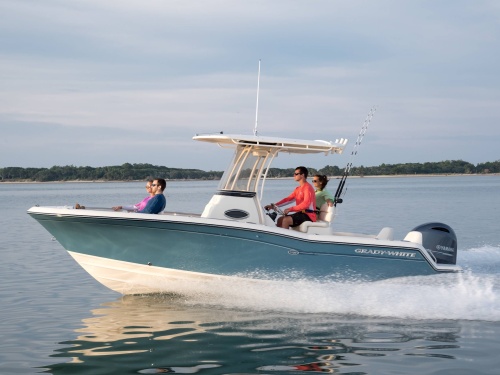Access More Boat Tests
Already have an account? Login
Grady-White 251 CE (2015-)
1 x 300-hp Yamaha F300
Brief Summary
The Grady-White 251 CE is the first model in the Coastal Explorer series that is specifically designed for the millions of people who live near large bodies of water and want to go boating both in protected water and along the coast as well. Further, the 251 CE has been carefully designed to incorporate all of the best features that have proved to be popular with families who enjoy watersports activities such as swimming, beaching, and towing sports. Our test boat was powered by a single 300-hp outboard that gave her a top speed of 49.2 mph and a range of 211 statute miles at best cruise.
Key Features
- 74-quart forward port & starboard insulated fish box w/ob drain
- Aft bench seat with port and starboard folding backrests
- Opening console portlight with screen
- Hydraulic trim tabs with indicator and retractor
- Aft swim ladder
- 4 rod holders aft and 6 vertical rod holders storage forward
- Helm leaning post with removable backrest
Test Results
| RPM | MPH | Knots | GPH | MPG | NMPG | STAT. MILE | NM | dBa |
|---|---|---|---|---|---|---|---|---|
| 600 | 2.9 | 2.5 | 0.6 | 4.8 | 4.1 | 333 | 290 | 60 |
| 1000 | 5.3 | 4.6 | 1.2 | 4.4 | 3.8 | 307 | 267.1 | 67 |
| 1500 | 7.5 | 6.5 | 2.2 | 3.5 | 3 | 245 | 212.9 | 71 |
| 2000 | 9.5 | 8.2 | 3.8 | 2.5 | 2.2 | 177 | 153.8 | 77 |
| 2500 | 13.4 | 11.6 | 5.4 | 2.5 | 2.2 | 175 | 152.3 | 80 |
| 3000 | 19.9 | 17.3 | 6.6 | 3 | 2.6 | 211 | 183.6 | 84 |
| 3500 | 28 | 24.3 | 9.4 | 3 | 2.6 | 210 | 182.5 | 90 |
| 4000 | 32.7 | 28.4 | 11.9 | 2.7 | 2.4 | 193 | 167.7 | 90 |
| 4500 | 37.7 | 32.7 | 16.7 | 2.3 | 2 | 159 | 138 | 92 |
| 5000 | 41.6 | 36.1 | 20.3 | 2.1 | 1.8 | 144 | 125.3 | 93 |
| 5500 | 44.9 | 39 | 26.6 | 1.7 | 1.5 | 118 | 103 | 96 |
| 5700 | 49.2 | 42.8 | 26.9 | 1.8 | 1.6 | 128 | 111.6 | 97 |
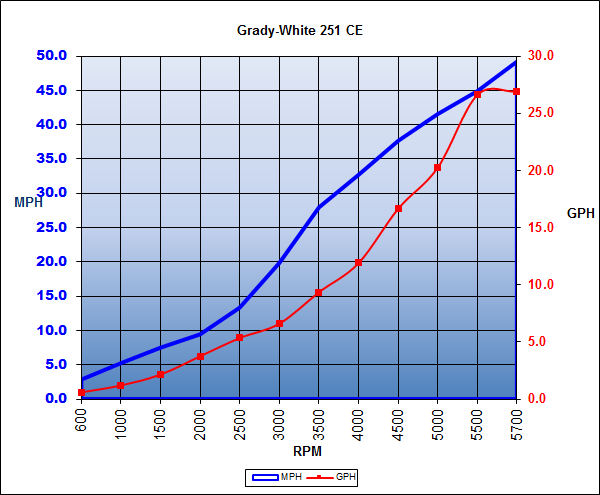
Specifications
| Length Overall | 24' 7'' / 7.49 m |
|---|---|
| Beam |
8' 6'' 2.59 m |
| Dry Weight |
3,715 lbs. 1,685 kg |
| Tested Weight |
5,013 lbs. 2,274 kg |
| Draft |
14'' .36 m |
| Deadrise/Transom | 16 degrees (SeaV2® progression) |
| Max Headroom | N/a |
| Bridge Clearance |
8'1" 2.46 m |
| Fuel Capacity |
78 gal. 295 L |
| Water Capacity |
10 gal. 38 L |
| Total Weight |
5,013 lbs. 2,274 kg |
Acceleration Times & Conditions
| Time to Plane | 2.5 sec. |
|---|---|
| 0 to 30 | 7.8 sec. |
| Ratio | 1.75:1 |
| Props | Yamaha Saltwater Series 2 18T-15 1/4 |
| Load | 2 persons, full fuel, no water, 50 lbs. of gear |
| Climate | 48 deg., 45 humid.; wind: 5-10 mph; seas: light |
Engine Options
| Tested Engine |
1 x 300-hp Yamaha F300 |
|---|---|
| Std. Power |
1 x Yamaha 300-Hp 4-Stroke |
 Learn More
Learn More
Watch Our Video
Mission Statement
The mission of the 251 CE is to serve the boating needs of the whole family that live near large bodies of water, such as the Atlantic Ocean or the Great Lakes, but who also go boating in protected water, such as the ICW, estuaries, or rivers. Further, she is designed to be a coastal fishing machine -- or, a watersports cruiser with all of the functions and utility of a deckboat. By providing a versatile platform that can be optioned with equipment to take her in one direction -- or in several directions -- the 251 CE can actually perform virtually all of the functions needed for 80% of coastal boaters.
Overview
The 251 CE has a hull that draws just 14" (.36 m), making her ideal for inshore fishing both with rod and reel and for net casting. To that end, she has bow and stern casting platforms and everything in between that veteran anglers need.
With just 20” (.51 m) of cockpit depth, the 251 Coastal Explorer becomes a functional deckboat. The addition of a bow, beach re-boarding ladder (the only one we have ever seen on a center console), chaise, plenty of seating in the bow, transom seating and a head with a standard Porta-Potti prove the 251 CE is more than just a fishing boat. With the addition of an optional tow pylon, the 251 CE can perform virtually all of the utility normally found in a conventional sportboat or deckboat -- plus a lot more.
Major Features
- Hull design by C. Raymond Hunt & Associates
- Stainless steel thru-hull fittings
- All 316-grade stainless steel
- 100% hand-laid hull and deck
- Dual 74-quart (70 L) fish boxes under the port and starboard bow seats
- Bow and stern reboarding ladders
- 10 flush-mounted rod holders
- Standard Porta-Potti
- Standard hydraulic tilt steering
- 47 sq. ft. (4.4 sq. m) cockpit area
- All drink holders, rod holders and pull up cleats are connected to tubes that allow water and condensation to drain onto the deck, rather than into the bilge.
Performance
The 251 CE has an LOA of 24’7” (7.49 m), a beam of 8’6" (2.59 m) and a hull draft of 14” (.36 m). With an empty weight of 3,715 lbs. (1,685 kg), full fuel and two people on board, we had an estimated test weight of 5,013 lbs. (2,274 kg). Tested with a single Yamaha F300 4-stroke outboard turning a Saltwater Series 2 -18T-15 ¼ prop, we reached a top speed of 49.2 mph at 5700 rpm. At that speed, we were burning 26.9 gph, which translated into a range of 128 miles.
Best economic cruise was measured at 3000 rpm and 19.9 mph. That speed reduced the fuel burn to 6.6 gph, which increased the range to 211 statute miles. That said, we did find a close comparison to that speed with regards to the range and mpg with the throttle advanced to 3500 rpm. That increased the speed to 28 mph, raised the fuel burn to 9.4 gph while only dropping 1 mile off the range. For that reason, we’d label 3500 rpm as “best cruise”. She’s also a quick boat with a 2.5 second time to plane, 5.1 seconds to 20 mph, and a 7.8 second time to 30 mph.
Sea V2 Hull
Any talk of the 251 CE's performance has to start with a discussion of the Sea V2 hull design. The C. Raymond Hunt & Associates-designed hull has a continually changing deadrise as the hull transitions forward. In this case, it starts at 16-degrees at the transom and increases from there as one moves forward.
A Key Design Factor.
This deadrise at the transom is somewhat less than we usually see on many deep-V center consoles which might be intended for blue water fishing work. That is precisely the difference that makes this design ideal for boating in protected and coastal locations. By foregoing a deep-V hull (which is not needed because the boat won't be takling 3' waves offshore), the 251 CE can be both far more stable at rest and at trolling speeds -- and, be faster and more fuel-efficient at the same time.
Family-Friendly.
By making the boat more stable, she is automatically going to be more comfortable for the whole family who may not be ready for deep-V rock and roll. Her low deadrise gives her shoal draft making her easy to beach, and ideal for anglers in skinny water.
Fast Hole Shot Times.
Because the deadrise is 16-degrees, rather than, 19 or 20-degrees, the boat is easier to push, which maximizes both top speed, fuel efficiency and lowers the rpm necessary to keep the boat on plane when throttling back. Skiers and wake boarders will like the boat's 2.5 seconds from zero to planing speed to get them up out of the water fast. Anglers involved with Le Mons starts in fishing tournaments can also benefit from this jackrabbit-like starting.
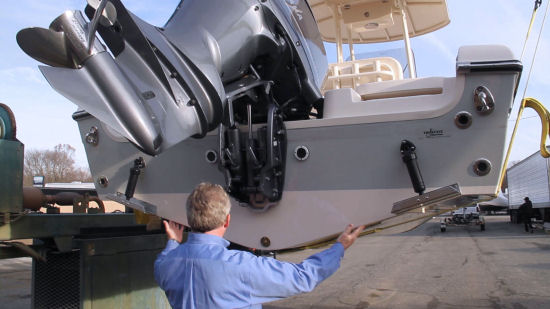
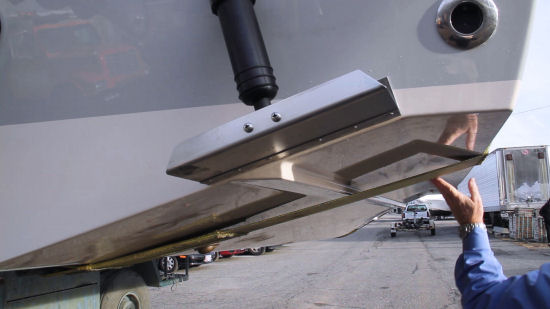
But a Soft Ride, Too.
Forward the hull has a sharp, deep-V entry that easily cuts through chop and short waves providing a smooth ride and little or no pounding, depending on speed and conditions. The wide bow flare keeps spray out and away from the boat providing a dry ride. The strakes also contribute to that dry ride acting as deflectors once the boat is on top.
So Does it Work?
In a word, yes. During our test, we sadly didn’t have any noteworthy sea conditions but we did do our share of experimenting with self-generated waves and found several things that are worth sharing. But remember, this boat is intended for protected and coastal waters, so we were actually able to replicate her intended environment.
First, There’s Good Tracking.
This hull design is touted as being able to allow the boat to track better in quartering seas. So we rode up to the wake of the camera boat and let it hit the quarter in a well-controlled manner and sure enough, we remained straight with hands off the wheel, when we should have been sent off in another direction. Check.
Second, Dry and Comfortable.
Crossing wakes at varying angles showed that the hard chine and strakes, combined with the generous bow flare, served quite well towards producing a dry ride. We also noticed a softer ride than expected in a boat with a 16-degree deadrise at the transom. That is because of the sharp sections forward cushion the ride when running through chop.
Third, is Stability.
She’s stable at rest so working either of the two elevated casting platforms will be a comfortable experience. Drift fishermen will certainly love this boat as she has a natural tendency to present her beam to the wind.
Helm
The helm is mounted to the port side of the console and accommodates two-across seating quite well. There’s plenty of open space for mounting a navigation display but Grady-White isn’t in the electronics business so that option is left up to the buyer to choose and install. We think that’s good news, as all too often a builder only offers one choice and that may not be the best for the consumer. Here, choose from all the manufacturers and the features desired.
The wraparound windshield is made of thick, sturdy acrylic, has little to no distortion at the curves, and is quite durable. A storage area located at the top of the console, is divided into two sections and padded at the bases. The switch panel is separated from the dash and the horn is instantly identifiable in red. Located in the center of the console is the Yamaha multi-function display.
Below, the wheel is mounted to a tilt base. The engine controls are state-of-the-art digital so they are easy to move and precise. Two drink holders are to starboard with the stereo and a grab handle just above.
Features Inspection
Fishing
Being, first of all, a center console, it’s hard to start anywhere other than with the fishing features. (The family amenities run a close second.) Be that as it may, the fishing category needs to start with a mention of the 47-sq. ft. (4.37 sq. m) cockpit area. This provides plenty of room to move about on deck without any feeling of being constricted by seating or the leaning post. As noted above, the supports for the optional T-top are bolted to the console and not the deck, making moving around the console non-problematical for even portly anglers.
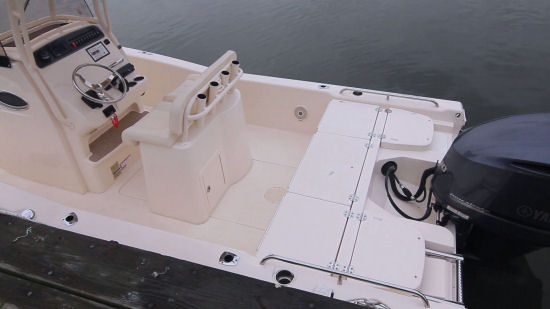
The aft casting deck
is U-shaped and provides its own measure of freedom to move about. All hardware is flush-mounted, eliminating any tripping hazards. There is storage to both sides, and a 12.75-gallon (48.3 L) insulated raw water livewell w/light & ob drain in the middle.
Just ahead is a leaning post with a grab handle. The absence of a work area behind the post is probably what adds to the feeling of roominess in the cockpit. However, there is storage at the bottom port side of the post and organizers are included.
18 Rod Holders.
Four flush-mounted rod holders are in the caprails, two to each side. Forward, just abaft the bow seating, are six vertical rod holders, making a total of 10 as standard. Eight more were included from the back of the deluxe leaning post and up on the back of the T-top. That adds to 18 rod holders on our test boat.
Huge Bow Casting Deck.
Forward there’s another casting deck and part of it can be made up of an insert that serves double duty as an optional bow table. Normally when we see that sort of combination we have a knee-jerk reaction of thinking that we need to limit weight, as tables aren’t generally made to hold excessive loads. Not so here. This is a heavy-duty table that can take the proverbial 800-lb. gorilla. It is made specifically for both rod and net casting, as well as to be a table -- and, leg rest for a chaise lounge.
The deluxe leaning post
Also includes an insulated 25-gallon (95 L) livewell located under the observer’s seat. The catch can be deposited in one of the two standard 74-quart (81.5 L) fish boxes that make up the bow seats/casting deck.
Also, at the bow there’s a raw water washdown spigot. All too often we see these at the stern, which requires a long hose to reach the bow. Since all decks are typically slanted towards the stern anyway, why not have the water connection at the bow? Here it is, making short work of the washdowns while underway.
"Family" Features
What is a "family" feature? Basically, anything that makes the boat more comfortable and also adaptable to watersports. Our test boat was loaded with all of them and frankly taken together they create a remarkably versatile boat with high utility. It is safe to say that she could go head-to-head with virtually any sportboat or deckboat on the market as far as functionality goes.
Console Seat with Cooler.
It starts with the usual seat ahead of the console. A dedicated seatback cushion is mounted to the console and the whole seat is molded into the console as a single unit with back support contours. Further, this is something not found on sportboats.
4-in-1 Bow Table.
An optional table can be ordered and we highly recommend it. Not only does this table enhance the utility of the bow area for lunch or drinks, but it also comes with a cushion and a telescoping pedestal. That means it can be lowered to convert the forward console seat into a doublewide chaise lounge… a rare commodity on a boat of this size and class. With it placed forward in the casting deck position, it can be covered with cushions making a huge bow sun pad.
Bowrider Seating.
Both the side bow seats have aft sections that lift up to form a pair of chaise lounges. In this configuration, the seats are virtually the same as those found on a dual console or a bowrider sportboat. The difference is that we can't think of a bowrider that also has a third forward-facing seat just behind -- or a third chaise with the employ of the lowered table with cushion.
Beach Re-Boarding Ladder.
One of the unique -- and important -- standard features on the 251 CE is her beach boarding ladder. At one time or another, virtually all boaters want to beach their vessel to get off and explore or have a picnic ashore. By selecting the right beaching site, raising the outboard a bit, this 14" (.36 m) draft vessel can be easily beached and the bow ladder can be deployed. If the angle of the bottom is right, the ladder can reach dry land. Otherwise, only feet and ankles need to get wet.
Transom Seating.
Virtually all sportboats have transom seating and so does the 251 CE. Here the seats are lying flat across the casting deck and we only have to reach back to lift the port and starboard seat backs up from their flush position. This leaves the space under the seats untouched and Grady-White was then able to hinge these to add storage underneath. This creates three-across seating with the two jump seats having seatbacks.
Storage Bins.
And still not to be outdone in the creative use of space department, the storage under these seats consists of removable bins that when lifted, allows access to the components underneath, such as the battery switch to starboard. Pretty clever.
Shower in the Stern.
In the port caprail there’s a covered optional freshwater shower wand. Simply put a finger under the forward lip of the top, lift and pull out the sprayer. That’s all there is to it and it is frankly a better design than we see on many sportboats. It is plumbed to a 10-gallon (38 L) freshwater tank.
The Head.
And of course no boat that touts its “family features” would be complete without the head. Grady-White includes a Porta-Potti as standard.
Quality Details
Like all Grady-White boats, the 251 Coastal Explorer is well-built using the best materials and construction practices. Start with the cleats... all are made of 316 stainless and the pull-up type. But then all of the stainless on the 251 CE is 316 ss. Drink holders drain into the cockpit which drains overboard, not into the bilge. All electrical wiring is protected from the saltwater environment. Thru-hull fittings are bonded and the company rigorously follows ABYC standards. Probably the most important quality detail, however, has nothing to do with materials or build -- it is Grady-White's customer service. The company has long been known for keeping owners happy and fixing things that might go wrong. Back in the days when J.D. Powers surveyed boat owners, Grady-White won top ranking in its category every year.
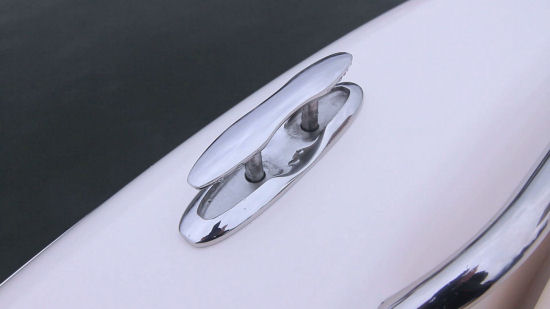
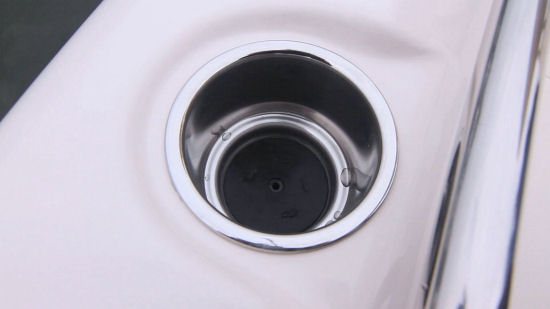
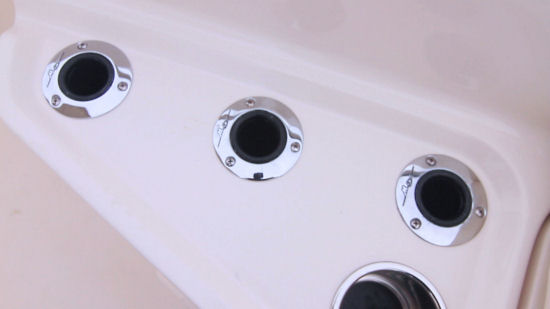
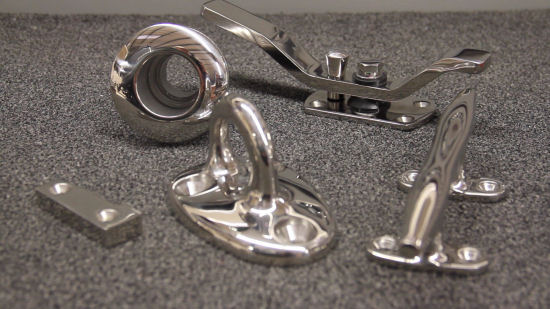
Options to Consider
One of the strong points of the 251 CE is that the builder has created an excellent list of standard features. This allows families and fishermen to get all they could possible want out of a single vessel. Below are some additional options to consider:
Observations
When it comes to versatility, it seems that the 251 CE has both coastal fishing and coastal watersports boating covered hands down. She’s also a comfortable boat to be on in these locales. Because she is not designed for offshore, bluewater work, her bottom does not have to be as deep, nor does her freeboard have to be as high, among other things. That means there can be a considerable savings in materials, labor, and therefore, cost. When we compare the 251 CE with three other 25-footers in Grady-White's other series offerings, we find that she is as much as 900-lbs. (408 kg) lighter. That, in a nutshell, goes a long way to explaining why she can also be less expensive than the other Grady-White boats this size. Because she is purpose-built, the wise consumer can take advantage of this cost savings if their application is a match.

